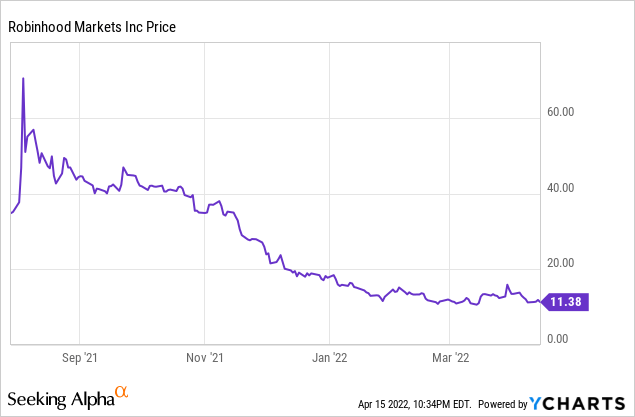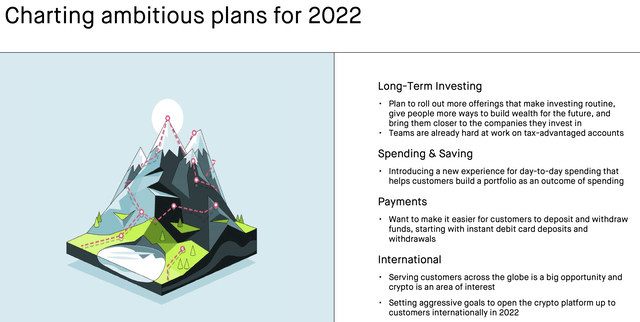Spencer Platt/Getty Images News
We all know this fact but are often too risk-averse to act on it: there’s never a better time to invest than in a crisis. And while the whole market (and especially tech stocks) have been in turmoil this year, few stocks have been hit harder (both from a stock price perspective as well as fundamentals) as Robinhood (NASDAQ:HOOD).
Once a Silicon Valley darling and a hot commodity during its IPO, Robinhood has seen significant declines in its stock since it went public. At issue is the fact that, especially since the start of the year, trading activity is way down. Compared to 2021, when the markets were in a bullish mania and retail investors clambered over each other to trade the latest meme stocks, 2022 has been dull and dreary in the markets – and that directly impacts Robinhood’s revenue.

Still, I see hope for this company. When we take a step back, we have to remember the longer-term bullish drivers for Robinhood:
- Robinhood is dominating in the millennial/Gen Z demographics that will soon overtake the bulk of worldwide wealth. Traditional brokerages are still catching up to Robinhood’s popularity. Market cycles have always occurred and will continue to occur; there will be periods of frenzied trading and there will be periods of calm. But over the arc of time, Robinhood’s share of market activity will grow.
- Product innovation never stops. Part of what makes Robinhood so appealing is that it’s often first-to-market (or at least, first to popularize) many new key features. Crypto trading, cash advances, and easy access to low-cost margin were some of Robinhood’s key defining advantages; other upcoming features include 24/7 trading and retirement accounts.
- Profitable on an adjusted EBITDA basis. Robinhood is roughly just above breakeven on an Adjusted EBITDA basis. At a much larger scale, the company will be able to drive significant profit expansion.
In my view, it’s the perfect time to buy into Robinhood for the long haul (though bear in mind that a recovery may take a year or more to play out) after its stock is down ~80% from all-time highs.
Robinhood’s aggressive product roadmap continues to differentiate it from its peers
Right now, investors are bearish on Robinhood because the general perception is that investor interest in the platform has permanently declined. I couldn’t think this to be farther from the truth. While trading frequency and mania has certainly died down from 2020/2021 levels, I think Robinhood’s continuous focus on platform expansion and product rollouts will drive boosted engagement from its user base.
Robinhood 2022 roadmap (Robinhood Q4 investor presentation)
Robinhood’s driving mantra, of course, is to make investing accessible to everyone. This means opening the door to all types of accounts and account holders. To date, Robinhood has only offered traditional brokerage accounts, but in 2022, the company plans to roll out retirement accounts (Traditional and Roth IRAs).
This is the perfect time to be launching retirement accounts, just as many of Robinhood’s younger users are thinking about starting their retirement nest eggs for the first time. IRAs also carry the advantage of being longer-term accounts that users will typically hold onto and grow over a long period of time, hopefully helping to reduce churn on the platform.
Robinhood is also hoping to introduce securities lending in the first half of 2022. Securities lending helps investors earn extra cash on their stock holdings by lending them out to institutions for the purposes of short sales. Adding this feature in particular helps Robinhood A) entice investors to move more of their portfolios into the platform, and B) compete against Interactive Brokers, one of Robinhood’s fiercest competitors in the online/low-cost brokerage space (Interactive Brokers is currently offering both lower margin rates as well as securities lending capabilities, but where it’s weaker than Robinhood is that most accounts don’t offer free trades and the user interface is unfriendly to casual investors).
Though less splashy than retirement accounts and securities lending, Robinhood is also hard at work to start offering ACATS support. ACATS (or Automated Customer Account Transfer Service) is the means by which investors can move assets from one brokerage into another. Adding this support eases the friction that potential users will face when switching from another brokerage and into Robinhood.
On the crypto side, Robinhood is also releasing Crypto Wallets (where users can store and spend their cryptocurrencies securely) as well as the ability to gift crypto to other users. Crypto now represents nearly an equivalent amount of Robinhood’s transactional revenue as “vanilla equities.” What I think Robinhood does incredibly well in the crypto space is helping new crypto investors break in for the first time. Crypto’s popularity has soared since 2020, but trading through specialized exchanges like Coinbase can sometimes feel too advanced for nervous novices. Robinhood helps bring a patina of safety to crypto investors who are just about to wade in.
The company also hopes to open its crypto trading capabilities to users beyond the U.S. in 2022. Now primarily a U.S. company, Robinhood still has vast untapped potential customers to chase beyond domestic borders.
Funded accounts and revenue have largely stabilized
Without looking at the numbers, many investors have the impression that Robinhood’s user base has been decimated since last year’s trading mania eroded. This isn’t true: as can be seen in the chart below, Robinhood’s total funded accounts ended Q4 at an all-time record of 22.7 million users, adding 0.3 million net-new users within the quarter.
Robinhood accounts (Robinhood Q4 investor presentation)
New funded accounts in the quarter were 0.8 million – not quite as high as 5+ million in the first two quarters of FY21, but higher than 0.7 million in Q3. Churn, too, is down from Q2 and Q3. If anything, we can confidently say that Robinhood’s account base has stabilized. Jason Warnick, the company’s CFO, noted on the Q4 earnings call that churn rates have hit multi-year lows:
Turning to Q4, we added 300,000 net funded accounts during the quarter. New funded accounts totaled 800,000; churned accounts totaled 700,000; and resurrected accounts totaled 200,000. For churn, we saw a 19% reduction compared to Q3, and on a percentage basis, churn hit its lowest mark in the last year and a half. Lastly, we had $4.4 billion in net deposits from customers for the quarter, up 93% sequentially but down 32% on a year-over-year basis.”
Revenue is also not in as bad shape as many might think. In Q4 (Robinhood’s most recent quarter), total net revenue of $363 million actually still grew 14% y/y.
Breaking out the transactional piece of Robinhood’s revenue: we can see that equity trading revenue has stabilized at ~$50 million per quarter. While this is down -35% y/y, options revenue – now triple the contribution of equity revenue – is up by 15% y/y to $163 million in Q4. Crypto revenue is also up ~4x y/y, and while it’s not anywhere near the peak of Q2, crypto now contributes a roughly equivalent amount to revenue as equity trading.
Robinhood revenue breakdown (Robinhood Q4 investor presentation)
There’s no doubt that Robinhood’s business will always be lumpy and dictated by the mood of the markets. But market swings come and go, as they always have. At some point, trading interest will resume, and Robinhood’s wider platform of products and its growing user base will be able to capitalize on that moment.
Key takeaways
Don’t expect Robinhood to make a comeback overnight – but as long as you believe that investing will become more mainstream among retail investors and that trading activity will recover, there’s no reason not to buy Robinhood at all-time lows.


Be the first to comment